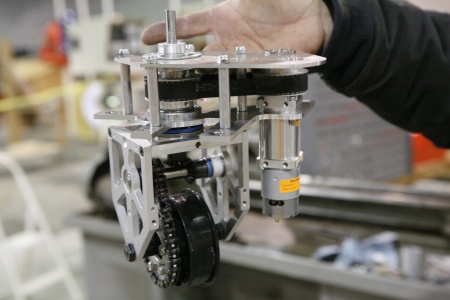DEWBOT VII Design Team Page
Head Mentor: Clem McKown
Student Lead: Sasha
Team:
- Carly
- Andrew
- Douglas
- Molly
- Scott Featherman
- Gary Deaver
- David Moyer
- Ben Kellom
- Siri Maley
Contents
Pivot Drive Value Engineering ("Straw Man") - 22-November-2010
- Ran a Value Engineering session on the 2010 Pivot Drive.
- Value Engineering Slides (ppt) including "Straw Man" proposal for modular Pivot Unit.
Wooden Man - 28-November-2010
- Based on feedback to the "Straw man" proposal on 22-November, an improved "Wooden Man" (pdf) design was developed to elicit further critique.
Scoring Models
Scoring Calculator that tallies individual and overall autonomous score, raw peg, uber-multiplied and logo bonus scores, race scores, and penalties into an overall match score. 9 Jan 2011, Siri.
Scenario Model allowing side-by-side and step-by-step comparison of 2 teleop scoring scenarios. 11 Jan 2011, Clem.
Strategy & Design
Results of the team's Game-Play Strategy Development sessions are available. 12 Jan 2011, Clem
Note that <G19> in The Game RevA appears to clearly rule out "the Strongman" Minibot strategy. 12 Jan 2011, Clem
The (second iteration of the) "end" result of our design process is highlighted in the DEWBOT VII Design Highlights Handout (Philadelphia revision). 5 April 2011, Siri
- There's also a half-page version of this document for mass distribution to teams. 7 April 2011, Siri
Field Elements
Logomotion Scoring Grid. 12 Jan 2011, Clem
Field Simulation views including pickup/scoring and minibot deployment. 28 Jan 2011, Siri.
Arm Analysis
Analysis of arm motion for a robot with a 2-joint arm playing Logomotion. 12 Jan 2011, Clem
Arm analysis 2 for a robot with a 2-joint arm playing Logomotion, includes all scoring pegs. 15 Jan 2011, Siri
4-Bar arm analysis for single-pivot arm playing Logomotion. 17 Jan 2011, Siri
4-Bar CAD report including all configurations with dimensions and actuation (pneumatic cylinders). 28 Jan, Siri.
Pivot Drive
Email to Programming Team: Last year, angle sensor orientation and wheel orientation were arbitrary. We dealt with this by installing a custom potentiometer panel which allowed a correction bias to be set to align the wheels.
Since our 2011 pivots will be modular, I propose that we calibrate the sensor to the wheel during assembly. Sensor output would then be fixed versus wheel angle relative to the pivot module. Since each installed pivot module has a specific orientation within the robot chassis, the sensor output would also be fixed versus wheel angle relative to the robot chassis as well (although not identical for all pivots). The need for on-robot pivot angle calibration should thereby be eliminated.
Regards, Clem (15-Jan)
Email to Programming Team: Pivot control mathematics utilize the values of the robot wheelbase length and width. DEWBOT VII is expected to have a somewhat different wheelbase than DEWBOT VI.
DEWBOT VI Wheelbase: 21.5 in (wide) x 28 in (long)
DEWBOT VII anticipated Wheelbase: 20.75 in (wide) x 30.75 in (long)
The mathematics for Pivot Drive are described in papers posted at: Pivot Wheel Documents
Bien cordialement, Clem (15-Jan)
Thermal fit calculations for the Pivot Tube/Pivot Top assembly - 15-January, Clem
Minibot
Analysis of Minibot deployment considerations and concepts. Updated 23 Jan 2011, Siri.
Email from Clem (1/24): I've adapted my 2008 robot drive-train model to the problem of FRC's 2011 MiniBot race. Model and some sample results are attached. I am not sure that all physical parameters (normal force on wheels to the pole, coefficients of friction,...) are correct. The model and results are provided as samples of what a model can provide.
I used a 0.5:1 gear reduction for the sample cases. I assumed 10 lb normal force holding the minibot to the pole and high-friction wheel surfaces (probably not so realistic).
I ran the cases for 4.5, 5.0 & 5.5 lb robots. Wheel radius was varied between 1.5 and 2.3 in in 0.1 in steps.
The primary factor affecting climb time is minibot mass. No big surprise here. The lighter, the faster.
However, wheel radius (a.k.a. gear ratio) plays a significant role and there is an optimum which is a function of robot mass. Given that we have fixed geal ratios (based on the Tetrix gears), the ability to turn a custom-radius wheel could provide a useful competitive advantage. Optimizing wheel diameter/gear ratio can cut tenths of a second off the climb time.
So, to win the Minibot race:
1. Minimize Minibot mass (seconds to be saved here)
2. Deploy quickly
3. Optimize wheel diameter/gear ratio (tenths of seconds to be saved)
Regards, Clem
Will my magnetic minibot fall off the pole when the power starts up? What do I do? Find out here & do the math! - 24 Jan 2011, Clem
The effects or minibot mass and drive wheel radius was explored in detail - 31 Jan 2011, Clem
